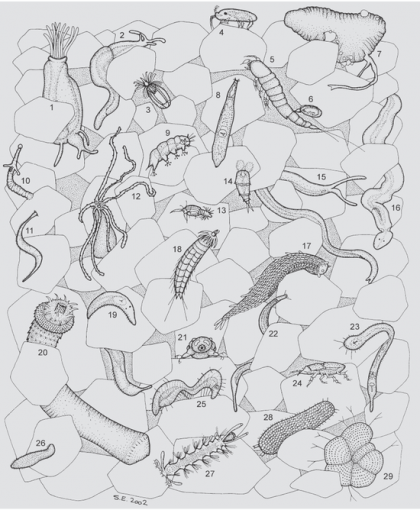
Meiofauna, I have recently learned, are small invertebrates that live in the sand and mud of ocean, lake and river bottoms.
As I have been digging in the sand of the Delaware Bay to count horseshoe crab eggs and track egg development, I have had my own encounters with beach meiofauna.
The most intriguing of these encounters has been with worms that seem to be attracted to horseshoe crab egg clusters. I saw this during my field work last year and was concerned that these worms were up to no good, perhaps preying upon the nutritious little eggs.
In my search for information, I discovered the $100 horseshoe crab book, The American Horseshoe Crab. My curiosity about crabs in general and this particular worm question got the best of me and I hesitantly shelled out the bucks.
Fortunately, I found that I wasn’t the only one seeing the worm fiesta at horseshoe crab egg clusters. One of the chapters in the book make brief mention of the phenomenon:
Large numbers of invertebrates (meiofauna), particularly nematode worms, are often seen in association with horseshoe crab eggs developing within the sand. Although the nematodes do not appear to be predatory or parasitic, the exact nature of their ineraction with the eggs is unclear.It may be that the sticky material that holds the mass together stimulates microbial growth, which in turn attracts nematodes.
As I have continued to dig and observe, I find the “harmless associate” explanation for the worms less convincing. I admit I haven’t done the CSI work necessary to really unravel this mystery, but I will tell you that as I have seen the eggs develop, I have also seen these worms “develop” as well. They are getting bigger!
Image purloined from the Fossil CSI blog
Another thing I have observed is that sometimes these translucent white worms appear to have something inside them that is the identical color to the green of the horseshoe crab egg. I think they have egg in their bellies.
I collected some of these guilty-looking worms alive in order to get pictures but by the time I got around to it, they had gone white again. I think the green stuff had worked its way through their digestive tracts.
There is much to learn about the interaction of the meiofauna with horseshoe crab eggs. It would stand to reason that the notoriously nutritious horseshoe crab egg would be capitalized on by the creatures living under the sand. It is an abundant, predictable resource for the shorebirds, so why wouldn’t it be for worms as well?